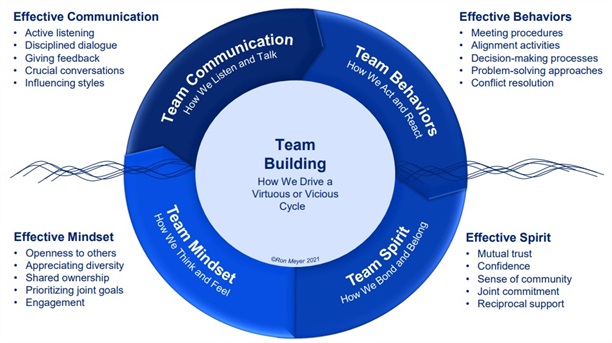Team Building Cycle
December 3, 2021 | 4 min read
How can I strengthen the effectiveness of my team? TIAS professor of Strategic Leadership Ron Meyer presents an insightful tool to kickstart your thinking: Team Building Cycle.
Key Definitions
Groups of people regularly work together to achieve common goals. Where people collaborate for a short period of time with a specific objective, such a group is called a coalition. When they cooperate more structurally, for a longer period on a shared agenda, they are called a team. In a coalition the individual interests prevail, while in a team the joint interest is dominant.
Team building is the process of strengthening a team’s ability to perform more effectively. This can be a virtuous cycle of becoming more cohesive and productive but can also spiral into a vicious cycle of increasing distance and dysfunctionality.
Conceptual Model
The Team Building Cycle illustrates the process by which four key team characteristics reinforce each other over time, making the team more effective. ‘Above the waterline’ it is visible how team members communicate with each other, which can strengthen how they subsequently behave among one another. These tangible behaviors then influence the team spirit ‘under the surface’, which in turn impacts how each person thinks and feels about the others and the team. This mindset consequently resurfaces as it affects team communication. In each corner of the model five examples are given of building blocks that can contribute to improving each of the four key team characteristics making up the cycle.

Download picture
Key Elements
The four key team characteristics that can be built up over time are the following:
1. Team Communication. Having open, clear, and fair communication between team members is crucial to joint effectiveness. All important topics need to be addressable (the what of communication), in a constructive and timely manner (the how of communication), so that the receiver understands what is intended (the who of communication). Improvements can be made, for example, by getting better at listening to each other, engaging in more disciplined dialogue (see model 29), developing a feedback culture, ensuring that uncomfortable issues are talked about and bolstering influencing skills.
2. Team Behavior. Team members also need to work together in an effective and efficient way to achieve their joint objectives. This requires them to assign roles and responsibilities to each individual (division of labor), while at the same time establishing ways to align their efforts on an ongoing basis (coordination of labor). Especially this collaborative behavior is challenging but can be greatly improved by, for instance, running meetings in a better manner, clarifying who is responsible to make which decisions, developing stronger joint problem-solving skills and paying more explicit attention to conflict resolution methods.
3. Team Spirit. How team members communicate and behave will strongly influence the atmosphere and the feelings of attachment to the team. If individuals feel psychologically safe among one another, and valued by their teammates, they will start to bond and feel a sense of citizenship and belonging. This esprit de corps is crucial for getting team members to fight for each other (the joint interest first), instead of against each other (the individual interest first). It can be improved, for example, by building more mutual trust and confidence, while encouraging stronger commitment, sense of community, and reciprocal support.
4. Team Mindset. How people experience the team spirit will in turn impact how they think and feel about being a member of the team. Where they feel strongly attached to their teammates (personal connection), they will generally be more receptive, respectful, and forgiving to each individual. This can be further improved by fostering openness and appreciation for diversity. Where members also feel strongly connected to the idea of the team (team identification), they will more quickly think from a team perspective. This can be enhanced, for example, by stimulating them to take ownership and prioritize joint goals.
Key Insights
• Not every group is a team. The term team is often used very loosely to refer to any group of cooperating people. But even many ‘management teams’ are not really teams, but coalitions, as their members don’t prioritize the joint interest over the individual interests.
• Team building is a cycle, not a pyramid. Lencioni’s popular pyramid model of team dysfunctions (2002) suggests that team building is a linear process, starting with strengthening trust and ending with attention to results. This is simplistic. Team building is an ongoing cycle, with four factors mutually reinforcing each other.
• Team building happens above and under the surface. Some team characteristics are visible to the observer, namely how team members listen and talk to each other (team communication) and how they act and react to each other (team behavior). Other characteristics are under the surface and therefore not visible, namely how team members bond and build belonging (team spirit) and how they think and feel (team mindset).
• Team building is challenging. Building a high performing team requires work on all four fronts, each with multiple areas for potential improvement. No five easy steps to success.
• The cycle can be virtuous, but also vicious. Team building requires going through the cycle multiple times, gradually spiralling up. But poor communication and ineffective behaviors can undermine the team spirit and mindset, leading to worse communication and behavior, setting a vicious downward spiral in motion.
Inspired by this kickstart?
The six-day
Masterclass Personal Leadership will teach you how to lead people by establishing a connection. You will learn how to identify the underlying motives of others and how to use this knowledge to shape your leadership. At the same time, you will gain insight into your own motives, leadership styles, strengths and weaknesses.
Read more »
Team Building Cycle is part 30 of a series of management models by prof. dr.
Ron Meyer. Ron is managing director of the Center for Strategy & Leadership and publishes regularly on
Center for Strategy & Leadership.